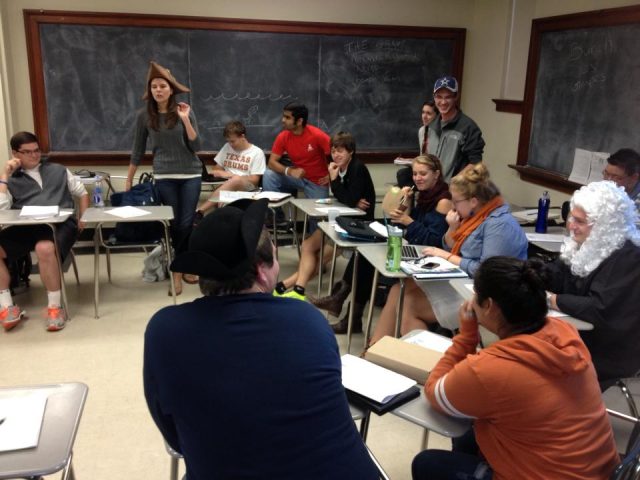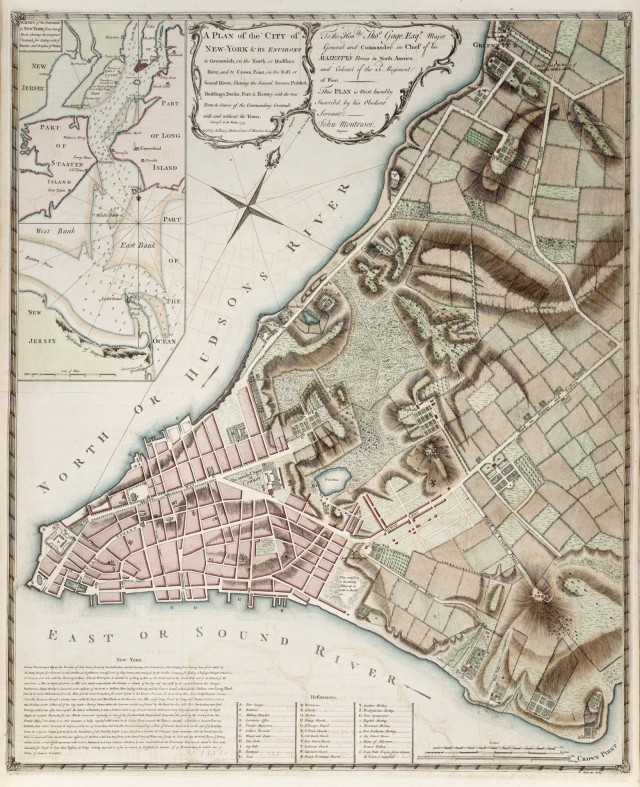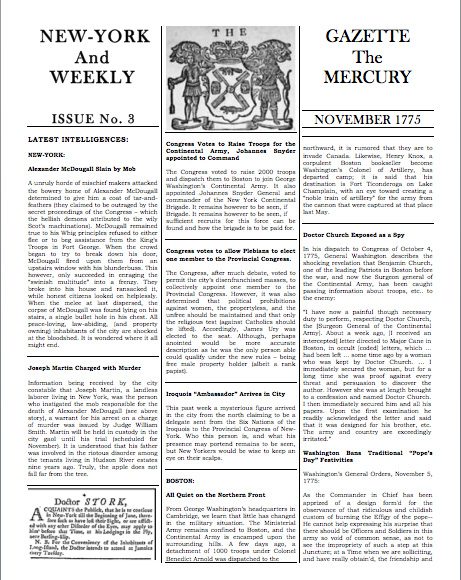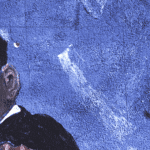Two students stand back-to-back in the center of the room. At my signal, they step in opposite directions, turn, and shoot. Afterward, one crumples to the floor dead while the rest of the class erupts in cheers of glee or howls of outrage. This scene took place in my classroom last fall. My students were all “in character,” acting the part of historical figures. The duelists were Abraham Brasher, a New York City silversmith and member of the “Sons of Liberty,” and Christopher Billop, a Staten Island farmer loyal to the king. Although Brasher and Billop were both genuine historic figures and real political foes, their fatal meeting never actually took place. The student playing Billop had provoked the duel, gambling that if the dice fell his way (the projectiles they each “shot” were not bullets but dice), Brasher’s death might prevent the New York Provincial Congress from voting for independence.
Such fictitious events and “unhistoric” outcomes are an integral part of a class that I have taught for the past few years called “Debating the American Revolution.” The class was first inspired by the book Patriots, Loyalists, and Revolution in New York City, 1775-1776 written by William Offutt (a history professor at Pace University in New York City). This book is part of a series called “Reacting to the Past” launched in the late 1990s by Professor Mark Carnes of Barnard College. Each of books in the series focuses on a particular historical event or debate. Carnes believed that students would be more engaged with history if they encountered it as a participant rather than as a spectator. In the case of Offutt’s book, the chosen setting was New York City in the period between the start of the revolutionary war in April 1775 and the passage of the Declaration of Independence fifteen months later, and the historical debate was whether or not New York should join the American Revolution.
As soon as I read Offutt’s book I knew that I wanted to try it. However, as I became more excited about the idea, I also became convinced that I would need an entire semester, and not merely the five weeks he allotted, to do the job properly. I believed the students’ role-playing would be more historically accurate if they were given a deeper background in the ideas and material life of late colonial New York before the “game” began.
In my course we devote the first half of the semester to background research. We begin by discussing things colonial New Yorkers would have, or at least could have, read. These include extracts from “classics” of early modern political theory (Locke, Hobbes, and Montesquieu) as well as from less well remembered writers such as Lord Bolingbroke, and John Trenchard and Thomas Gordon’s “Cato’s Letters.” From there we progress to reading the pamphlets published on both sides of the Atlantic during the imperial crisis of the decade prior to 1775. We finish with political tracts written by colonial New Yorkers themselves. Students read an essay by the loyalist parson, Samuel Seabury, writing under the pseudonym the “Westchester Farmer,” and the robust rebuttal penned by Alexander Hamilton, then a twenty-year-old student at Kings College (now Columbia University).
From the world of political ideas, we move on to the nitty-gritty of daily life. To give students a sense of the physical landscape of colonial New York City, we pore over a wonderful map of the southern end of Manhattan Island made by an officer in the Royal Engineers on the eve of the revolution. On the map, the city sits on the southernmost tip of the island, occupying an area about the same size as UT’s campus. Colonial New Yorkers still lived in close proximity to the countryside. On the engineer’s map, Greenwich village was still literally that, a rural hamlet separated from the city proper by a mile and a half of fields and forest.
Yet, despite its small size, colonial New York City was a surprisingly urban place. With approximately 25,000 inhabitants, the city was the second largest in the colonies (after Philadelphia). Crowded together into such a confined space, in buildings only three or four stories tall, all colonial New Yorkers, rich and poor, black and white, lived in close proximity to each other. They walked the same broad streets or narrow alleys and often slept beneath the same roofs (although the poor – or enslaved – were likely to be relegated to cramped and unheated attics, or dank basements).
Lastly, each of my students is tasked with reading one month’s worth of a newspaper printed in New York City between July 1773 and March 1775. Digital versions of these and many other Early American newspapers are available online through the UT library web-site. Then as now, newspapers are written for the moment; yesterday’s newspaper is used to wrap the fish. Everything you read in the paper speaks to immediate concerns. We will never know if the runaway slave advertised for by his master escaped or was caught and returned for the reward. In the woodcut that accompanies the advertisement, he is caught in mid-stride, perpetually on the run. My students are naturally appalled by such notices, but they also are intrigued by the minutiae of a distant time and place whose fervent desires (for wealth, good health, fashionable attire), and fears (illness, debt, death) seem surprisingly familiar.
Besides writing papers on their newspaper reading, the students present their findings to the rest of the class. Because each student reports on a different month between July 1773 and March 1775, listening to their presentations in chronological order encapsulates the last stages of the imperial breakdown as it was happening. This sense of the impending crisis ends in April 1775, the first meeting of the New York Provincial Congress, and the start of the “game.”
At last, midway through the semester, comes the moment everyone has been waiting for. From a tri-cornered hat, each student draws the name of his or her character. I leave the room for five minutes and anyone unhappy with their “lot” can try to persuade someone to trade with them. I then give every student a sealed envelope containing secret information about their character which they are not to reveal to anyone and which they should use to guide their conduct in the game.
Each character belongs to one of four larger groups or in 18th-century language “factions.” Five students are patriots, charged with promoting the revolution and declaring independence. Four students are loyalists, tasked with preventing the same. Another four classmates are “moderates,” members of the Provincial Congress who have yet to decide between the first two options. This moderate bloc forms the “swing vote” whose support the patriots will need to win if they are to prevail. The tri-partite division of our in-class Congress echoes John Adams’s post-war calculation that at the start of the revolution Americans were evenly divided between patriots, loyalists, and neutrals.
The patriots’ challenge of winning over the moderates is made harder by the last and largest segment of the class representing the great majority of colonial New York’s inhabitants: those people who were not permitted to vote or sit in the Provincial Congress. In our class, this group consists of two poor men, two women, two slaves, and a clandestine Catholic. In class, we call the politically disenfranchised the “People-Out-of-Doors” (or PODs). This was a polite 18th-century term for people more often called “the lower sort,” the “mob,” “crowd,” or, in Edmund Burke’s memorable phrase: “the swinish multitude.” In modern political parlance, we might call them “the street.”
In the early modern era, however, people excluded from the formal political process could still make their opinions known by means of popular protest. Once each class session, I ask the back of the classroom where the PODs gather if a mob is forming in the city’s streets, and if so, who is the crowd’s target and what is their demand? Those confronted by a mob have three choices: capitulate to the mob’s demand, flee (in which case they cannot vote in that game session), or resist. The latter choice could end in tar-and-feathers or even death.
Although their power lay in numbers, each of the PODs also has an individual agenda. Slaves want to gain their freedom. One of the women seeks the right to divorce her absent ne’er-do-well husband. All of the PODs would like political rights, and a chance to vote in the class’s ultimate vote on independence. To this end, they must persuade the Congress to remove the disqualifications, whether of property, gender, or religion that barred them from having political rights in the colonial period. Both the patriot and loyalist factions fear the mob’s wrath, but they also see it as a weapon that can be used to threaten their opponents and whose actions might be swayed by promising to support some of the “liberal” reforms.
With the possibility of adding members to the Congress (as individual PODs gain the vote), as well as the likelihood of subtracting them (either permanently by death, or temporarily by flight), you can see how complicated the political calculus and game strategy can become and why the weekly game sessions of the class as well as the weeks between classes were filled with intense negotiations and intrigue.
At the start of each week’s game session students meet briefly with the members of their group to plan and plot. Afterwards comes the most formal item on the agenda: speeches. In the course of the game, each student has to write and present two ten-minute-long speeches. Although everyone speaks from the same podium at the front of the classroom, members of the Congress are presumed to be speaking before that assembly, while the PODs pretend to address the tavern-table-democracy at the “Bunch O’ Grapes” tavern, located across the street from the statehouse I am always pleased (and, to be honest, surprised) by the earnestness and skill students display in portraying their characters and presenting their opinions to the rest of the class. Nor does the rest of the class sit idle while the speeches were being made. I encourage the audience to interject freely with cheers, and table-pounding when they approve of what the speaker says or with hisses or cries of “rubbish!” when they disagree with the sentiments being expressed.
Besides speaking and voting, students’ are also required to submit two anonymous (or pseudonymous) letters to our in-class newspaper. The letters allow for a great deal of mischief (the Billop-Brasher duel began when the former planted a letter falsely accusing the latter of beating his wife), but the assignment also reflects a historical reality, for the print culture of the 18th-century was filled with pseudonym and imposture. Famous examples in early American history include young Benjamin Franklin’s “Silence Dogood” letters, or the contributions made to the New York newspapers by “Publius,” (a composite of James Madison, Alexander Hamilton, and John Jay) which urged ratification of the Constitution and which are now collectively known as the “Federalist Papers.”
Students first send their letters to me (so I know who wrote what and can assign grades), and I remove their actual names before publishing the letters in the our newspaper, “The New York Gazette and Weekly Mercury” that I distribute before each week’s meeting.
Our in-class newspaper also provides students with a short reminder of the previous week’s class and what was scheduled to happen this week. Most importantly, the paper advances the hands of time. Each weekly session of the game is set three months after the previous one from April 1775, until our sixth and final session: July 1776. Each issue of the newspaper informs the students what had happened in England and in the other colonies since the last game turn. These “outside” events, decisions, and declarations, drawn verbatim from the actual historic record, force students to react to the changing political and military situation as events in America and Britain spiral toward revolution.
It is this ongoing “course of human events” (to quote from Jefferson’s Declaration of Independence) that drives the game. For example, if the main item on the patriots’ agenda in the April 1775 session was to get New York to join the economic boycott of Britain, by the next week’s session (July 1775), the war has begun and the patriots are charged with answering the call of the Continental Congress to raise troops for General Washington’s new Continental Army. By the winter of 1775, New Yorkers read of the royal governor of Virginia’s call to arm slaves who agree to fight for the King against their patriot masters. In the spring of 1776, the newspaper includes extracts from Thomas Paine’s “Common Sense,” then hot-off-the-press.
My loyalist students find the rising revolutionary tide vexing. Often, when they read the latest issue of the newspaper they learn that their carefully negotiated agreement with the moderate faction has been undermined not by the radicals in Philadelphia, but by the hard-liners in London, and by a British policy that becomes increasingly militaristic and intransigent as the year wears on.
Eventually, the middle ground erodes, and everyone must choose sides. Most of the moderates reluctantly join the patriots. Those PODs who have gained the vote, also tend to lean patriotic, reasoning that their new found liberties depend on the success of the American cause. All my classes thus far have voted to declare independence and join the revolution when the push finally comes in July 1776.
But what I find fascinating is that no two classes have arrived at that destination by the same route. John Adams once famously remarked that getting the Congress to declare independence was like trying to “make thirteen Clocks, Strike precisely alike, at the Same Second.” As Adams’s remark suggests, until July 1776, the American Revolution consisted of thirteen closely related but distinct crises. Each colony followed its own peculiar political path to independence, shaped in part by the colonies’ own particular histories and circumstances, but also by the choices made by individual actors. No two of these thirteen revolutions were exactly alike.
In trying to make the revolution happen in our class, my patriot students often unknowingly follow the actual historical paths that lead one colony or another to join the revolution. For example, when one class voted to print paper money in order to pay for the troops required by Congress (risking inflation and the wrath of the poor), they inadvertently adopted the same course their historic predecessors chose in the New York Provincial Congress. In another case, the class-appointed commander of New York’s Continental Brigade ordered his troops to purge the Congress and declared New York to be independent by something like a military coup-d’etat, (which parallels what actually happened in Pennsylvania).
Playing historical characters based on real historical sources immerses my students in ideas, events, and drama of the American Revolution. Better than any class I have ever taught, this format teaches students how history is woven from the interaction between structure and contingency, between the warp of the larger forces of economics, politics, and culture and the weft of immediate consequence of events and of individual choice. In “Debating the Revolution,” my students learn about history by helping to make it.
As to what my students feel they get out of the class, perhaps the best way to illustrate this is to let one of them speak for herself. Sara Gordon shared this description of her experience in the course, written for another purpose, with me:
“Every week, I temporarily become Bathsheba Spooner, an impoverished laundress who supports women’s civil rights and the Patriot cause. As Bathsheba, I yell my opinions and pleas through the windows of the Colonial Assembly, I argue with my fellow people-out-of-doors regarding what the best course of action for our colony of New York would be, and I march through the streets with the Daughters of Liberty.
I am able to become Bathsheba through my History 350R seminar class entitled “Debating the American Revolution.” Though this class began with a . . . study of British and early American political theory and a detailed summary of the years leading up to the American Revolution, it was not long before my professor, Dr. Robert Olwell, assigned us each a character from the colonial time period, and as a class, we began historical role-playing.
I must admit, I was at first skeptical and hesitant about this aspect of the class. I have such a deep interest in the study of the American Revolution that I was inclined to prefer a more traditional lecture and discussion based class. This class, however, has made me incredibly glad and grateful to be a history major. When my peers and I enter the classroom, we take on our assigned character’s identities. We have set aside time for faction meetings, for congressional discussion and voting, for court, and even for mobs. Each class period is intense, and we must each be able to truly represent our character and argue, debate, and vote as if we are he or she.”
In “Debating the American Revolution,” history comes alive for my students, and, in the end, that is what I hope to achieve in all of my classes.
The New York Gazette and Weekly Mercury (A full issue of the course newspaper.)
More books in the series, Reacting to the Past







